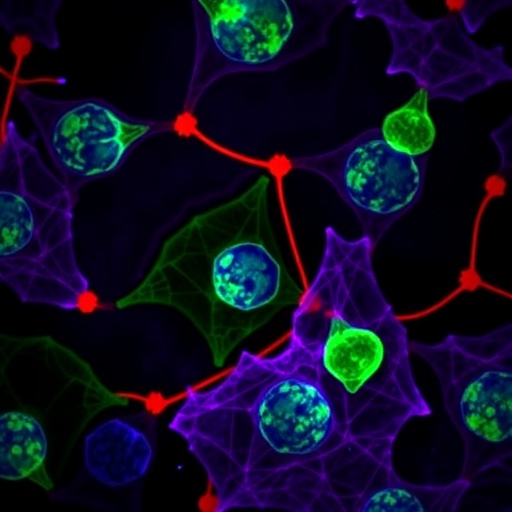In a groundbreaking study poised to reshape the landscape of ovarian cancer therapeutics, researchers have uncovered a novel pathway through which sericin, a natural silk protein, induces apoptosis in ovarian cancer cells. This discovery, centering on the microRNA-34a (miR-34a) pathway, offers promising avenues for targeted treatments with potentially fewer side effects than conventional chemotherapy. As ovarian cancer remains one of the most lethal gynecologic malignancies worldwide, innovations in understanding its molecular underpinnings are urgently needed. The latest research spotlights a natural compound capable of triggering programmed cell death in OVCAR-3 cells, a widely studied ovarian cancer cell line.
Sericin, a significant by-product of silk processing, has been under scientific scrutiny for its diverse biological activities, including antioxidant, antimicrobial, and wound healing properties. However, its role in cancer biology has only recently emerged. The team led by Hosseini et al. embarked on an exploration of how sericin interacts at the molecular level to induce apoptosis, the process of controlled cellular self-destruction critical for maintaining tissue homeostasis and combating tumor proliferation. Their findings open an exciting chapter in biotherapeutics where natural proteins manipulate cancer cell fate through intricate genetic pathways.
At the heart of this research lies miR-34a, a microRNA well regarded for its tumor suppressor functions. MicroRNAs are short RNA sequences that regulate gene expression post-transcriptionally, fine-tuning cellular responses to internal and external stimuli. MiR-34a specifically has been implicated in multiple cancers for its ability to promote apoptosis, inhibit proliferation, and impede metastasis. The new study demonstrates that sericin orchestrates a regulatory cascade elevating miR-34a expression, which in turn activates downstream effectors leading to cell death in ovarian cancer cells.
The experimental framework utilized OVCAR-3 cells due to their relevance as a model for poorly differentiated ovarian adenocarcinoma, mirroring clinical tumor behavior and drug resistance. Upon treatment with sericin, researchers meticulously measured changes in cell viability, apoptosis markers, and expression levels of miR-34a. The results unequivocally revealed a dose-dependent increase in apoptosis, correlating with an upregulation of miR-34a. This robust link underscores the therapeutic potential of modulating microRNAs to abolish cancer cells selectively.
Moreover, mechanistic insights gained from this investigation explicate that sericin does not act indiscriminately but instead triggers cellular pathways involving p53, a tumor suppressor protein that regulates the transcription of miR-34a. p53 is often termed the “guardian of the genome” because of its role in preventing genome mutation and malignancy. By activating p53, sericin enhances miR-34a expression, leading to programmed cancer cell death. This dual engagement with pivotal cancer control mechanisms highlights sericin’s precision as an anticancer agent.
The study also navigates through downstream targets of miR-34a, which include genes involved in cell cycle regulation and apoptosis inhibition. By repressing anti-apoptotic proteins and cell cycle promoters, sericin-induced miR-34a effectively halts division and survival of tumor cells. This multi-layered gene regulation offers a comprehensive assault on cancer cells, minimizing chances for resistance development, which often hampers existing cancer therapies.
Importantly, the natural origin of sericin adds an appealing dimension to this therapeutic approach. Unlike conventional drugs that frequently exhibit high toxicity and adverse effects limiting patient tolerance, sericin’s biocompatibility suggests a safer pharmacological profile. This encourages the notion of integrating sericin-based treatments either as monotherapies or adjuvants to existing chemotherapy, potentially reducing drug dosages and enhancing efficacy.
The implications of these findings extend beyond ovarian cancer. Since miR-34a dysregulation is a hallmark in various malignancies, sericin or its derivatives could be explored as broad-spectrum anticancer agents. Future studies designed to assess sericin’s effects in vivo, including animal models and clinical trials, will be crucial to validate its effectiveness and safety across cancer types. Furthermore, delineating the precise molecular interactions in different tumor microenvironments will help tailor sericin-based interventions.
Technological advancements enabling precise microRNA modulation have paved the way for next-generation therapies. Harnessing sericin to stimulate endogenous miR-34a provides a natural, targeted method to reprogram cancer cells towards apoptosis. This strategy contrasts sharply with generic cytotoxic agents by focusing on reactivating intrinsic tumor-suppressive circuits, a hallmark of innovative cancer treatment paradigms.
In light of these discoveries, the oncology research community is hopeful that sericin represents the tip of the iceberg in exploiting natural proteins for cancer therapy. The synergistic interplay between natural biomolecules and genetic regulators such as microRNAs could transform the therapeutic pipeline, reducing treatment costs and improving patient outcomes globally.
The study also reflects an interdisciplinary approach where molecular biology, nanotechnology, and natural product chemistry converge. This integrated research methodology fosters a deeper understanding of cancer biology while facilitating rapid translation from bench to bedside. Collaboration across fields will be essential to unlock additional benefits of sericin as a versatile therapeutic agent.
As the global burden of ovarian cancer continues to rise, innovative treatments that minimize invasiveness and maximize precision are paramount. The ability of sericin to induce apoptosis through the miR-34a pathway provides a beacon of hope, marking a significant milestone on the road to personalized cancer medicine. Continued research may soon enable clinicians to utilize sericin as part of an effective arsenal against ovarian cancer’s notoriously high recurrence rates.
In conclusion, the identification of sericin as an apoptosis inducer through the miR-34a regulatory pathway not only deepens scientific understanding of cancer cell biology but also chartes novel therapeutic strategies rooted in nature. This breakthrough underscores the invaluable potential natural products hold in revolutionizing cancer treatment, potentially shifting paradigms in how malignancies are confronted across the medical landscape.
Subject of Research: Ovarian cancer treatment; molecular mechanisms of apoptosis; microRNA-34a pathway modulation by sericin.
Article Title: Sericin induces apoptosis in the ovarian cancer cell line (OVCAR-3) through the miR-34a-related pathway.
Article References:
Hosseini, L., Salimpour, S., Alipour, M.R. et al. Sericin induces apoptosis in the ovarian cancer cell line (OVCAR-3) through the miR-34a-related pathway. Med Oncol 43, 3 (2026). https://doi.org/10.1007/s12032-025-03129-x
Image Credits: AI Generated




